How Netflix’s ‘Spirit Rangers’ Is Rewriting Animation’s Native and Indigenous Representation

For decades, American Indigenous and Native communities were represented by two prominent characters in mainstream studio animation: Pocahontas and Tiger Lily. With Spirit Rangers, creator Karissa Valencia is changing that.
“We wanted to redo a lot of that in terms of source material,” the Chumash and Mexican creator tells The Hollywood Reporter of the inspirations for historical representations of Indigenous peoples in animation. “We were doing our homework, our research. We were not just basing it off of what we did a Google search on.”
More from The Hollywood Reporter
Brandi Carlile, Adam Lambert and Ciara Among Those Set to Perform at "Can't Cancel Pride 2023"
Charlie Brooker Is Still Pro-Technology Despite "Bleakest Stories" Yet in 'Black Mirror' Season 6
Netflix at Annecy: 'Nimona' Debuts; 'Chicken Run 2' Gets Release Date
From Netflix Animation, Laughing Wild and SuperProd Animation, the series follows Kodi, Summer and Eddy Skycedar, three siblings whose blended Chumash and Cowlitz family work as rangers in the fictional Xus National Park in California. While the adults monitor the park during the day, the siblings solve various problems by activating beaded necklaces that portal them to the magical dimension of Spirit Park. Once there, the three spirit rangers — a grizzly bear cub, red-tailed hawk and a turtle — use their elemental powers to save the day.
Debuting in October 2022, the show centers the traditions, beliefs, art, music and more of the family’s American Indigenous tribes, with the express approval of the Chumash and Cowlitz communities. But across its two seasons, and now with a third on the way, the series has featured a number of other groups Indigenous to America and other parts of the globe. That includes Canada and New Zealand, with Valencia telling THR she often turns to her own writers, cast and crew when expanding the show’s representation of Native identity.
“I just see everybody as these environmental warriors,” Valencia, a member of the Santa Ynez Band of Chumash Indians, says. “We’re starting in a California National Park, but there are spirit rangers all over the world protecting their homes. So who are the spirit rangers in Australia or in Southeast Asia? They know their land, homes and stories well.”
Through its dedication to authenticity and representation, Spirit Rangers has already left a mark. Valencia is Hollywood’s first California Native showrunner and, with her debut, has built TV’s first all-Indigenous writer’s room. The show’s impact also trickles into its crew, where more than 100 Indigenous and Native creatives join the Spirit Rangers team in every aspect of the production, from sound and composition to art design and voice acting.
All of this was first happening while other Native-focused productions like Reservation Dogs, Rutherford Falls and Prey were coming up. Valencia says she regularly turned to her own writers and crew, as well as members of the other series’ creative teams, for their input, support or creative checks. It was the kind of collaboration that has helped further the showrunner’s storytelling ambitions for a community that’s rarely seen itself in this way on screen.
“I’m just so grateful for all of Native Hollywood really helping and coming out and saying yes,” she says. “I think kids stuff gets overlooked a lot, but they were like, ‘Nope, this is important. I’m signing up.'”
Spirit Rangers Created a New Talent Pipeline
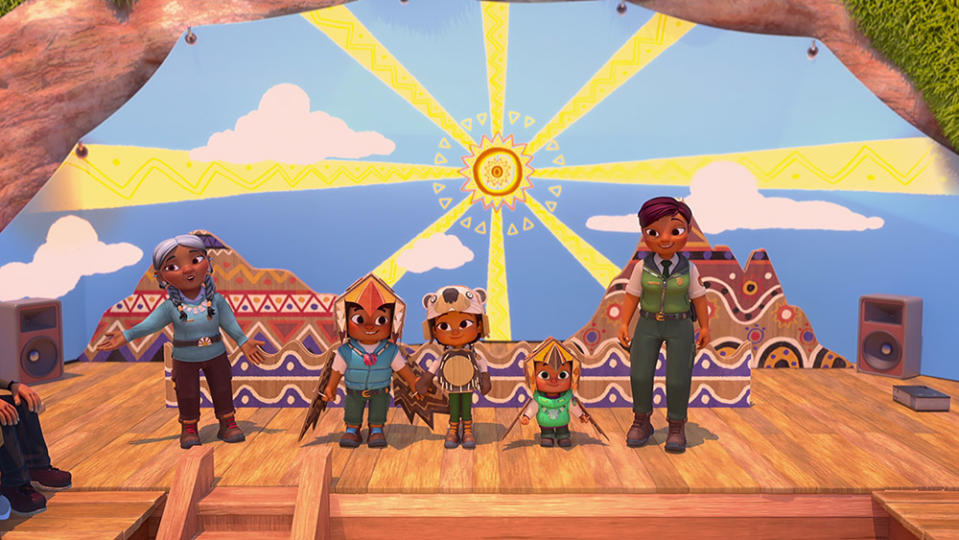
Alice’s Wonderland Bakery showrunner Chelsea Beyl helped throw Valencia’s name into the mix when the role of script coordinator opened up on the Disney preschool show Vampirina, created by Laughing Wild founder Chris Nee. But it would be Valencia herself and a two-page pitch for a horror show featuring Indigenous folklore that ultimately put her on the path to Spirit Rangers.
Valencia admits that she initially had her “nose in the air” about programming for preschool, but after seeing how Nee was telling stories, she was inspired. So when the producer, who was in an overall deal with Netflix at the time, asked Valencia over lunch to send her ideas for a show, the Spirit Rangers creator jumped at the chance. Valencia dusted off that earlier horror concept and retooled it for a preschool audience, with a focus on Indigenous values like morals, community, friendship, family, respect and connectedness.
Nee sent her a development offer within days, and the two would work together for a year, expanding the concept into a show Bible, before writing the pilot and selecting SuperProd Animation as the studio. “Being connected with Chris taught me a lot about mentorship. Her helping me is how I wanted to also help new voices, new Indigenous talent, too. Who could I pair them with? How can they succeed and get the mentorship they need as well to do a good job,” Valencia says.
Valencia went on to hire a wave of Native and Indigenous talent, many of whom were relatively new to the industry, had never worked on a major-studio backed production or in animation at all. “For the majority of these people, this is their first big break, including myself,” she says of Spirit Rangers‘ team. “So my goal was to always have a Native voice in the room at every department level — at least one. Then they would never be alone because I would always be here in their corner.”
She also turned to other members of Native Hollywood to help her navigate this brand-new territory. “Netflix did not have the infrastructure to support finding Native talent or anything of that nature. If I needed a clapper stick, I had to call my family, not them,” she explains. “So I leaned on these other shows and showrunners and artists. Like Wes Studi and Tantoo Cardinal [voices of Sunny and Moon] normally don’t do animation, but they knew how important this was and wanted to be a part of it.”
In addition to the Native Hollywood veterans who voiced characters for the show and who have worked on its crew, Valencia tapped into new and emerging talent through both traditional and nontraditional pipelines. That included reaching out to Native American arts organizations like L.A. Skins Fest.
“They had a really good list of different programs and writers, and they just started animation programs. So I connected with them early on to say, ‘Hey, this is what I’m doing,’ and they sent me recommendations,” the showrunner says. “They had a bunch of people ready to go.”
The Show Uses a Network of Paid Consultants and Tribes
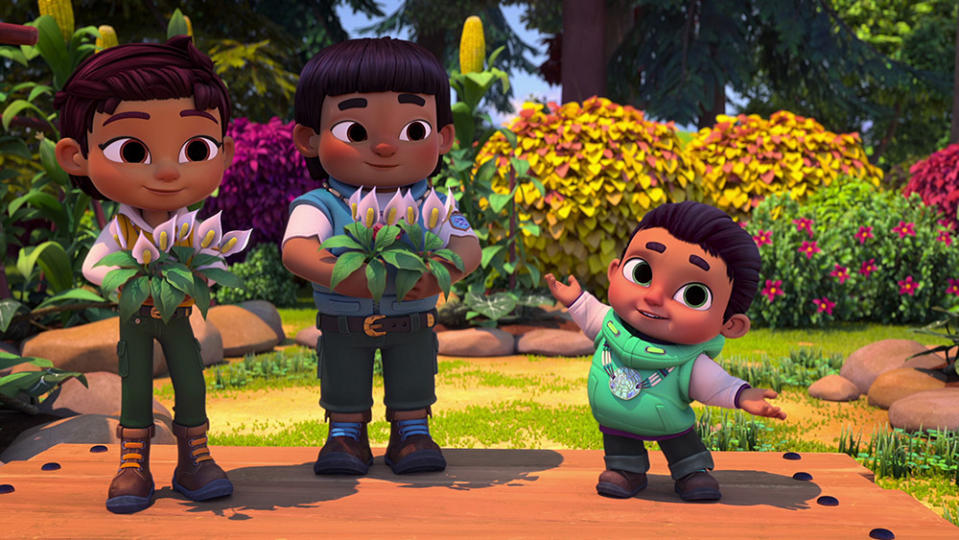
Between working as an American Indian Studies department chair and the director of the California Indian Culture & Sovereignty Center at Cal State San Marcos, Joely Proudfit has been meeting with Valencia once a week for nearly three years. The duo discuss everything from cultural instruments and choreography to language, food and tribal designs in the series. It’s a breadth and depth of work that the board chair of Vision Maker Media, a leading organizing in content by and about Indigenous people for public broadcasting, says she’s only ever seen projects get close to in her 28-year career.
“For Spirit Rangers, early on, we were able to work together to make those foundational structural changes and inclusions that set us up to be successful,” the Spirit Rangers‘ Native production consultant says. “And because Karissa is a California native person and the first ever California Indian showrunner, we were able to do this with the intentionality of centering California Indian voices like you’ve never seen before.”
Proudfit has helped Valencia navigate the diverse web of America’s Indigenous communities, going as far as bringing in multiple families to help produce a hoop-dancing episode. But she isn’t working alone. Netflix gave the series a full consultation budget to call on a team of experts — versus a single person — to ensure cultural accuracy within the series. “When you’re asking people for their time and expertise, you need to pay for that,” she says. “Netflix did what probably has never been done before by allowing me the opportunity to go out and hire cultural consultants, sometimes for [individual] episode[s], to make sure that what we were doing was right and that we have buy-in from communities.”
Spirit Rangers’ creative team also relied heavily on tribal input when they could, rejecting the “old way” of leaning on Google searches. “We would send the links to the tribes, and they’d be like, ‘This is incorrect, but here’s a book or here’s our website,'” Valencia recalls. “There’s just so much misinformation out there. Leaning on the tribes directly was something we had to integrate into our system.”
Through those conversations, Valencia avoided homogenizing and mythologizing actual histories and cultural touchpoints. One test of that came early in development, as the team debated — and eventually passed on — Spirit Rangers going the Tiger Lily route of a made-up tribe and language if the Cowlitz and Chumash didn’t give permission to include their tribal cultures in the show.
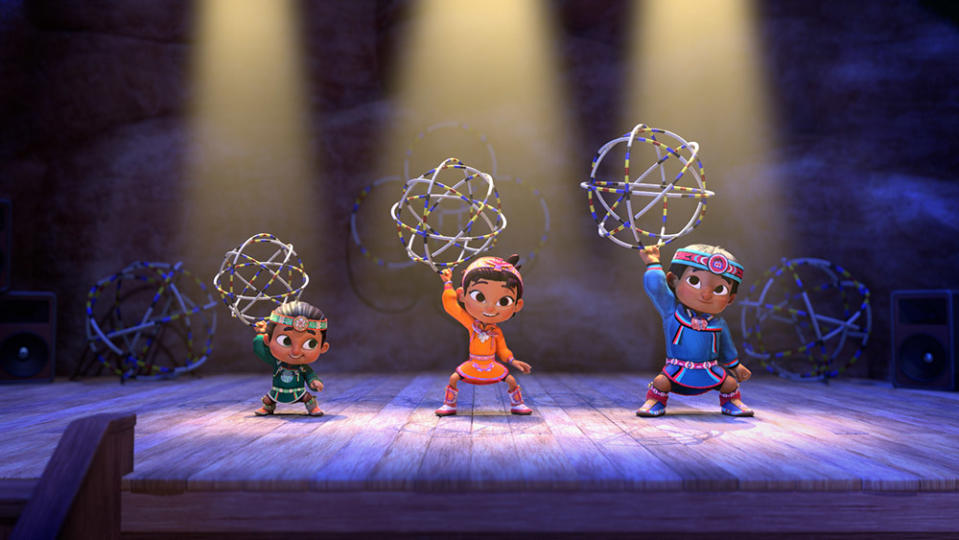
Another discussion arose around the show’s California tule reed tree house design, which was worked on by visual development artist Chris Aguirre, a Chihene Nde Warm Springs Band of Chiricahua Apaches member and the artist who designed the character Puss in Boots. The first design was a celebration of multiple architectural styles, from the Navajo’s hogans to the Great Plains tribes’ tipis. But when Valencia showed her tribe, they suggested using the ‘ap house style to show off Californian architecture — a suggestion driven by questions from young Chumash, who wondered whether their ancestors lived in tipis after seeing it on TV.
“It hit me like a truck,” Valencia says. “We have an opportunity to really change the narrative, and I can unlearn what I’ve seen on TV.”
Proudfit says the streamer also offered the chance to “give credit where credit is due” at the end of each episode, with Valencia telling THR the creative team came up with land acknowledgments in the credits to highlight that the show was made on California land. “In Native communities we don’t own stories, and they’re meant to be told for some at a certain time by a certain group in a certain season,” Proudfit explains. “So we didn’t want to violate any cultural norms.”
Diversity and Accuracy Were Key to Creating Characters and the Park
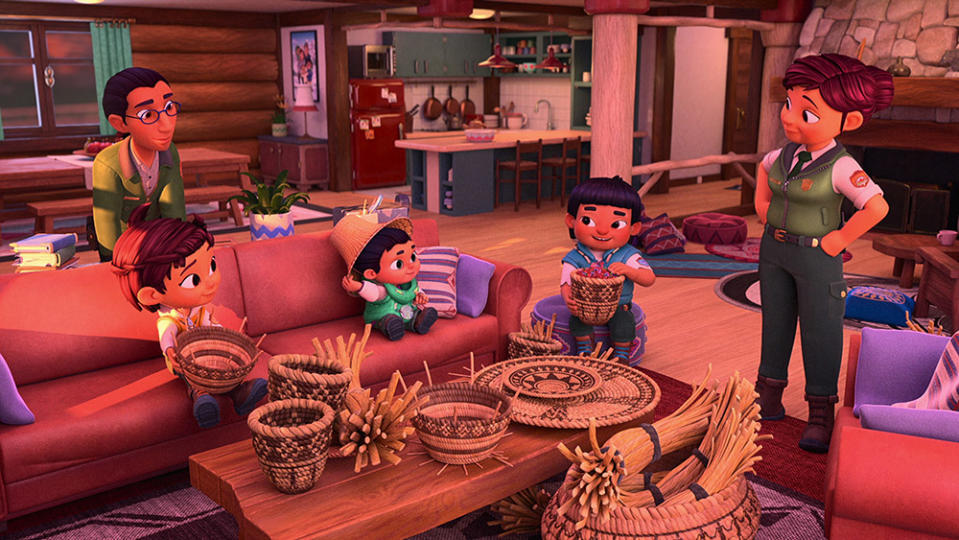
In 1995, Disney released what has become the most prominent representation of Indigenous people in animation: Pocahontas. The story has been heavily criticized for its misrepresentations, with Proudfit adding it was “radically wrong for women and girls alike” down to the art.
“We all have to try to live up to this idealized, over-sexualized image that was created by a white male animator who used a combination of Naomi Campbell and a Filipina model to create this beautiful character that doesn’t have characteristics of our bodies,” she says.
With few historical representations, Valencia — who was personally inspired by the half-Nigerian, half Native American Gargoyles’ character Elisa — says studios struggled with depicting Native cultures. “When we were testing for Spirit Rangers, a lot of them were relying on old Native stereotypes,” she says. “The one that stood out to me — SuperProd — brought something really new and fresh. What really got me was when they were designing the human world, they made the kids so cute and so realistic.”
The Spirit Rangers showrunner wanted her family to represent modern Native and Indigenous peoples who could be “in just shorts and boots, using their walkie-talkies for their jobs as Junior Rangers.” So with SuperProd’s initial designs in hand, Valencia turned to her consultants and crew to help shape things like the heroes’ skin tones and eye colors to address that “there’s no one way to be native.”
In one case, mothers of the voice actors Proudfit and Valencia “painstakingly” weighed hair lengths and styles for the siblings, who initially all had short hair. Aguirre, a visual development artist for the show, who saw various designs from the French studio SuperProd and handled visual research for Spirit Rangers including tribal outreach when possible, said the characters looked more South Asian — literally Indian — before he spoke with Valencia.
For the siblings’ Spirit Park heroes, the showrunner says she went with all California animals. Kodi was given a Cowlitz Coastal Salish print of thick lines and a crescent moon shape to “honor his Pacific Northwest roots,” Valencia says. Meanwhile, Summer’s design became a mix of the Chumash and the Cowlitz, with tribal patterns that are coastal Salish-inspired and a color palette inspired by California rock art. The last, Eddy, has prints based on the rock art from Chumash cave paintings in Santa Barbara and whose animal form — a turtle — is featured on the Chumash flag.
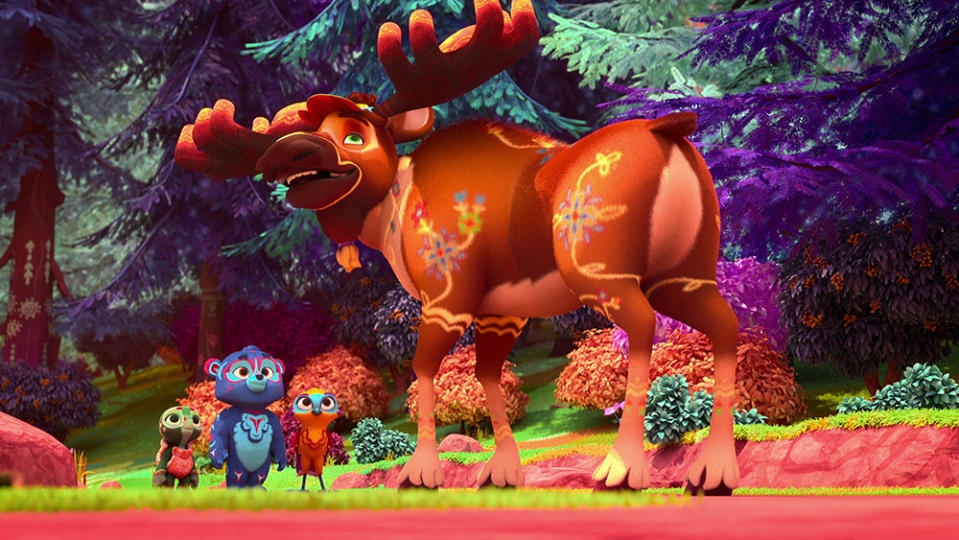
It’s a level of detail that translated to both the park and cultural items featured in the show in a way that celebrates the land, Valencia says. Viewers can glimpse poppies and the “iridescent blues and reds” of the siblings’ abalone shell necklaces within the show’s park. Basket designs — featured in the park’s visitor center scenes alongside a portrait of Samala Chumash matriarch Maria Solares — were vetted and approved by the Chumash to avoid lifting and directly copying patterns that have “belonged to families for generations,” Valencia says.
“Looking at the Choctaw Nation, the Navajo or Karissa’s tribe, I needed to be careful about the symbols that they use, the emblems and the colors,” Agurrie says. “Everything was very important to how they lived, so I had to do all my homework for the art director, so they could have all these reference points, from the clothing to the pottery to the traditions.”
According to storyboard artist Nicolette Ray, she has frequently found herself the lone Native artist on a project. But this series had an organized and supportive process that connected the animators with the writers.
“When you’re working with other Native peoples, there’s conversations that don’t really have to happen. There’s no need to set a foundation of, ‘We’re not a monolith,'” Ray, an Acoma Pueblo tribe member, tells THR of working on the production. “There’s so much Native people have in common in terms of our histories, struggles and who we are today — that’s where the real excitement and connection comes in.”
A Multigenerational Cast Expands What Being Native “Sounds” Like
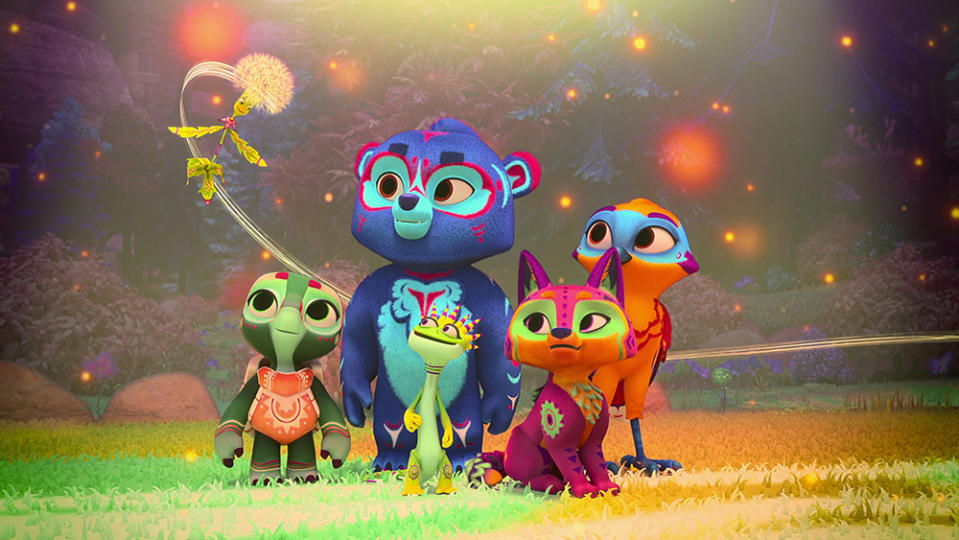
When Valencia began the process of seeking out voice actors for the Netflix animated series, she found herself running into a common hurdle and a “really difficult piece” of the Spirit Rangers puzzle. “There’s a lot of unlearning people have to do on what they define being Native American as,” she says. “If you’ve got two percent on your 23andMe, I don’t know if that means you should apply for this job.”
To help with this, the showrunner turned to Rene Hayes, who is not Native herself, but who has a history of casting for Native projects and has built relationships with numerous tribes. Valencia felt she could depend on Hayes, whom she says “understands our culture” sufficiently well to vet talent for a show that required all Native characters to be voiced by Native people.
Hayes’ experience was especially helpful when it came to finding the show’s young lead voice actors, Wačíŋyeya Iwáš’aka Yracheta (Kodi), Isis Celilo Rogers (Summer) and Talon Proc Alford (Eddy). “Finding our kids I knew was going to be a tough ask. I was really hoping to find Native American kids from the U.S. who could sing,” Valencia says. “It was a big search all over the country, and she connected us with some really great kids who I’m so proud of.”
Due to their age and experience, the young voice actors received training and support, and for one in particular, an entire studio was shipped to their reservation because access to a recording studio wasn’t possible.
The voice work has served as one of the biggest bridges between Indigenous Hollywood’s veteran and emerging talent on the series, with major Native Hollywood names boarding the project alongside its leading newcomers. But perhaps the most exciting part, says voice actress Kimberly Guerrero, is that it also offered an unprecedented chance for Indigenous voices and their “embodied knowledge of what it means to be Indigenous” to represent these characters.
It’s particularly significant in an industry that has not only historically cast white actors in non-white roles or dabbled in vocal stereotypes of various communities, but in a country where Indigenous and Native languages were intentionally suppressed.
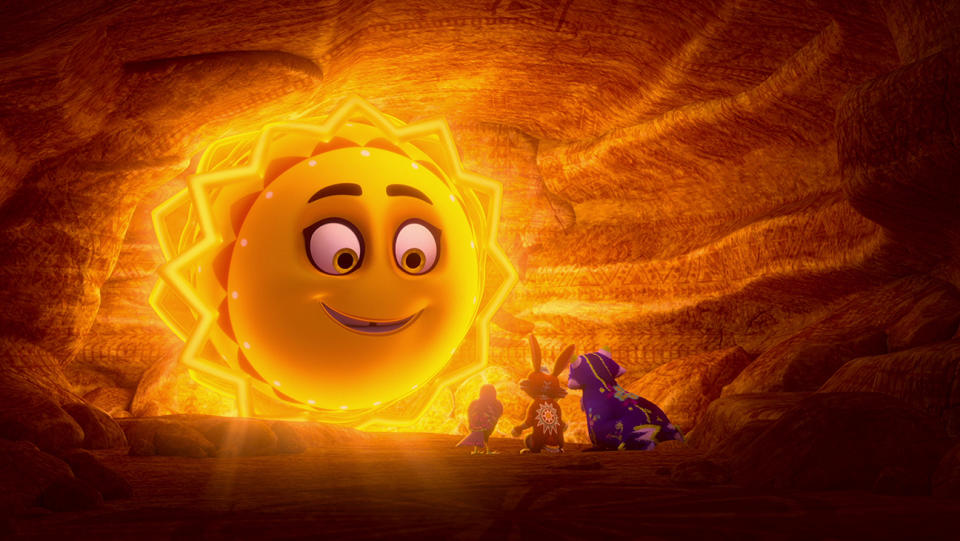
“I’ve been thinking about just how exciting it is to see the visual representation, the symbolism, the different cultures from all over North America, and expanding even to the Indigenous folks around the globe,” Guerrero, a reservation member of the Colville Indian tribe with Salish–Kootenai heritage who voices Mom Skycedar on Spirit Rangers, says. “But there is a resonance. Anybody that you would talk to from the Indigenous culture would say that [our] music and our drum and our songs, our prayers, our blessings are at the heart [of the show]. It’s an audible thing.”
And it’s the kind of representation the voice actor says Indigenous talent has “been waiting years and years — my whole life — for.”
“It would have been life-changing for me to have some kind of acknowledgement that we’re not just in a history book where you can read our words,” Valencia says. “Our Native folks will get to hear their language loud and proud. Haku is how we say hello in Samala and I remember thinking of little kids in Brazil or Germany saying Haku — it is actually very overwhelming. Our language is so fragile, and now it’s said out loud, all over the world.”
The Sound and Music Teams Created New Sample Libraries
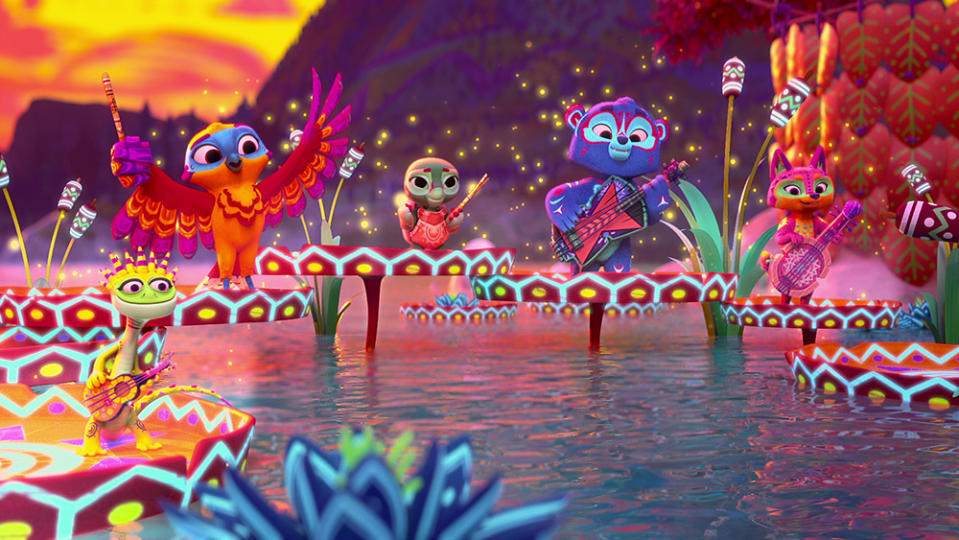
For Valencia, challenging the concept of what it means to “sound” Native was one of the more exciting parts of the series. “There is a stereotypical ‘Native’ sound. It’s that war drum, the eagle cry, the flute — it is in all the documentaries,” she says. “It’s very overdone.”
Wanting to celebrate Indigenous instruments while creating something that would capture the vastness of a national park, Valencia turned to her writing team and friends, who tapped into their own networks, which eventually connected her to Jordan Kamalu.
The Spirit Rangers’ underscore composer had worked in musical theater but never in Hollywood, a “greenness” that might be seen as a complication. But the Native Hawaiian’s humility and self-awareness as a newcomer, alongside his appreciation of the diversity of Indigenous identity, helped the show navigate new territory.
“With a show like this, you don’t have a lot of budget to record live players usually, so you rely a lot on a sample library,” Kamalu says. “I found some Native American sample libraries when I was very first crafting the sound for the pilot and I realized that within the limited number of libraries, almost all the vocal samples I was finding were Navajo. I had kind of assumed that the vocal chant from one tribe would sound a lot like another tribe, but Chumash vocal tradition is more songs, not so much plain chant.”
Valencia says that once Kamalu pointed out that what was missing from the score were the sounds of her own tribe, they sought out and received financial support from Netflix to create a new library of Chumash voices and instruments. Community singers from Valencia’s tribe — sometimes her own family — traveled to record vocal chants and songs at East West Studios, where the Chumash language could be heard “so loud and proud in a Hollywood studio,” she says.
Paired with veteran composer Jérôme Leroy for support and frequently leaning on Valencia and her fellow Chumash tribe members, Kamalu integrated deer hoof rattles, abalone shells and Valencia’s family’s clapper sticks into the soundtrack of the show. If a certain instrument wasn’t available, Jeff Carpenter, a Chickasaw Nation sound designer who worked with his tribe’s media production office for 15 years on documentaries, would have to recreate it. “He’s a champ,” Kamalu says. “He sometimes samples stuff and sends them to me to incorporate into the score.”
Carpenter says he relied on an “arsenal of Indigenous instruments in my collection — shakers, rattles, flutes,” as well as borrowed instruments like Valencia’s clapper sticks — to craft a wider “native underscore” for the series that reflected the various tribes introduced throughout the show’s first two seasons. While the show’s scoring sticks mostly to Cowlitz and Chumash instruments, the sound design goes wider, using water drums, clamshell shakers and Maori instruments from New Zealand.
Carpenter says he is careful about staying “true to the ambiances” of California — echoing the calls of its birds, for example — despite not living in the state. And whenever an instrument couldn’t be obtained in time due to the show’s production schedule, he’s communicated with experts from other tribes to help him understand how an instrument should sound. “There’s over 500 federally recognized tribes in the U.S., each with a different language, culture, instruments,” Carpenter explains.
“When I was thinking about Spirit Rangers, I was focusing more on Native Americans — Indigenous to America — because of our American national parks. But that doesn’t mean that we don’t have episodes about the Maori or our First Nations Canada folks,” says Valencia. “Anybody who identifies as Indigenous is somebody that I was excited to create with. When they’re bringing that love to the table, that’s what I’m excited about.”
Best of The Hollywood Reporter

